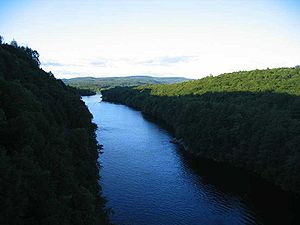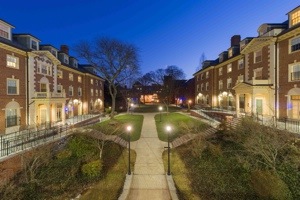
Celebrating water protection in N.E.
A stretch of the Connecticut River in western Massachusetts.
BOSTON
At a spot overlooking Boston Harbor, once choked with toxic pollution but now home to some of the cleanest urban beaches in the United States, advocates gathered July 1 to thank the Obama administration for closing loopholes in the Clean Water Act that previously left more than half of Massachusetts’s streams at risk of pollution.
“We’ve made so much progress in cleaning up our waterways, and we can’t afford to turn back the clock,” said Ben Hellerstein, state director for Environment Massachusetts. “The EPA’s Clean Water Rule will make a big difference in protecting Boston Harbor, the Charles River and all of the waterways we love.”
The Clean Water Rule, finalized in late May, clarifies federal protections for waterways following confusion over jurisdiction created by Supreme Court decisions in 2001 and 2006. It restores Clean Water Act protections to thousands of miles of streams that feed into waterways that provide drinking water for millions.
“In New England, protecting our water is more important than ever, especially as we work to adapt to climate-change impacts such as sea-level rise and stronger storms,” Environmental Protection Agency (EPA) Regional Administrator Curt Spalding said. “Protecting the most vulnerable streams and wetlands — a drinking-water resource for one in three Americans — helps our communities, and this rule provides clarity for businesses and industry without creating new permitting requirements.”
Before the Clean Water Rule became law, small streams, headwaters and certain wetlands were in a perilous legal limbo, allowing polluters and developers to dump into them or destroy them in many cases without a permit. In a four-year period following the rule’s creation, the EPA had to drop more than 1,500 cases against polluters, according to one analysis by The New York Times.
Prior to the passage of the Clean Water Act in 1972, Massachusetts waterways suffered from decades of pollution and neglect. As late as the 1980s, untreated sewage was regularly dumped into Boston Harbor, and high concentrations of industrial pollutants posed a public-health risk.
The Clean Water Act prompted a major cleanup of the harbor. Today, Boston boasts some of the cleanest urban beaches in the nation, and wildlife habitat has significantly improved, according to Environment Massachusetts.
Advocates pointed out that the Clean Water Act has enabled similar improvements in water quality in many of the state’s most iconic waterways, from the Charles River to the Connecticut River.
Despite broad public support for clean-water protections, polluting industries and some members of Congress are fighting to block implementation of the Clean Water Rule. In recent weeks, congressional committees have approved multiple bills aimed at rolling back the Clean Water Rule.
Boston becoming a solar Hub
BOSTON
The city has more solar energy per capita than most other major cities in the Northeast, besting New York and Philadelphia by a wide margin, according to a recently released report from Environment Massachusetts.
“For years, state and city officials have championed the growth of solar energy,” said Ben Hellerstein, campaign organizer with Environment Massachusetts. “Now, Massachusetts has a booming solar industry that is slashing the state’s carbon emissions, reducing energy costs and creating thousands of local jobs.”
The report, entitled “Shining Cities: Harnessing the Benefits of Solar Energy in America,” ranks Boston fourth in per-capita installed solar capacity in the Northeast, with more than three times as much solar per person as New York or Philadelphia. Among the 64 major U.S. cities included in the report, Boston ranks 20th for the total amount of solar installed within city limits, far ahead of cities such as Houston, Miami and Tampa.
Solar energy has grown by an average of 127 percent annually in Massachusetts over the past three years, according to the 62-page report, reducing greenhouse-gas emissions and curbing other forms of air pollution. In 2014, Massachusetts installed enough solar capacity to power 50,000 homes with clean energy, according to the report.
Through its Renew Boston program, the city has made it easier and cheaper for residents, businesses and organizations to go solar, with a goal of installing an additional 10 megawatts of solar energy by 2020. Last year, Boston and Cambridge launched the Race to Solar, a partnership aimed at bringing solar power to more nonprofits and small businesses.
The City of Boston also has an online solar map, in partnership with Mapdwell, a Boston-based MIT spin-off. This map provides residents and businesses accurate and accessible information about going solar. The tool has mapped all 127,000 buildings in Boston for their solar potential and found that Boston has the potential for 2.2 gigawatts of solar power.
“With some of the best incentives in the country, solar makes sense in Boston,” said Austin Blackmon, the city’s chief of environment, energy and open space.
Strong state-level solar policies have played an important role in fostering the growth of solar energy in Boston and across the state, according to Environment Massachusetts.
The state’s net-metering policy allows solar panel owners to receive fair compensation for the electricity they provide to the grid, Hellerstein said. Community shared solar projects are helping many families to access the benefits of solar energy, even if they rent their home or their roof can’t accommodate a solar installation.
The Levedo Building, in Dorchester, and the Old Colony Housing Project, in South Boston, are among the affordable housing developments that have installed rooftop solar panels.
“Solar power makes sense for a low-income community like Codman Square: It helps to lower resident energy costs, helps residents stay in place in their homes, and protects resident health by reducing air pollution, all while helping the city reach its climate-change goals,” said Gail Latimore, executive director of the Codman Square Neighborhood Development Corporation. “The Levedo Building, generates about 25 percent of its total electric consumption from a rooftop solar installation.”
Current legislation places a cap on the amount of solar power eligible for net metering, and the limit for solar projects in the National Grid service territory was recently hit, Hellerstein said.
Last month, some 120 supporters of solar energy, including advocattes for low-income people, business leaders, public-health advocates environmental activists, gathered at the Statehouse to ask state officials to take immediate action to raise the net-metering caps. Supporters also delivered letters signed by more than 350 municipal officials and more than 560 small-business leaders asking Gov. Charlie Baker to set a goal of generating 20 percent of Massachusetts’ electricity from solar by 2025.
The state’s solar industry now supports more than 12,000 jobs, according to Environment Massachusetts. More people work in the solar industry in Massachusetts than in any other state except California.
Robert Whitcomb: The light gets brighter and cars warmer
A New England winter’s compensations? I’m so fed up with it now that making this list took strenuous self-hypnosis.
First, of course, there’s the beauty and quiet. For brief stretches, all seems sinless, albeit with intimations of a monochromatic death. Of course, you might also hear cursing as people fight over a parking lot’s sole remaining space amidst six-foot-high piles of dirty snow.
To me, the two best winter pleasures are 1) walking at night, with a soft snow falling straight down in big fat flakes and 2) on a bright still morning right after a snowstorm, with almost blinding sunlight. My fondest memories of this season, which too many persist in calling “character-building,’’ are from living in New Hampshire in the mid and late ‘60s. The sun on the snow was an anti-depressant, especially after drab November.
A crucial aspect to enjoying a snowscape is lack of wind. That’s why you should stay away from our coastal cities, damp and exposed to the gales of offshore storms. Head inland.
Walking down a street in Boston or Providence on a winter’s day with a northwest gale is advanced masochism. I’d rather stroll on the same day in, say, Windsor, Vt. (where J.D. Salinger used to regularly eat in a diner), in the Connecticut Valley. Clean, dry and open, but with the worst of the wind blocked by the hills to the west. Very different from the narrow, clogged and frozen-slush streets of Providence and Boston, which weren’t designed for thousands of cars.
Then there’s late-winter “spring skiing’’. In the sun the air finally seems warm, the corn snow bouncy and soft and the air fragrant with wood smoke from the chimney of the base lodge. After a day on the slopes, a rich languor falls over you.
Another New England winter asset is liquid. The snowpack helps ensure that our region will have plenty of water to get through the year. New Englanders underestimate just what a valuable resource this, and how lacking it is in most of the Sunbelt. Of course, we could do much more with it, especially with hydro-electric power.
Winter also forces innovation. That may be why the Northeast continues to be America’s richest region. Consider the subway systems of Boston and New York. The Great Blizzard of 1888, which paralyzed the Northeast for weeks, helped lead Boston to create America’s first subway system, followed soon by New York. The MBTA mess from the recent blizzards should not obscure that having such a public-transit system has been a huge boon to the New England economy.
Cold winters also reduce the incidence of many diseases. Microbes prefer warmer climates. The healthier states are the colder ones, although we associate cold winters with the flu and colds.
Anyway, about now you notice that car interiors are warming up faster in the stronger sun, you hear the morning music of birds you haven’t heard for months and see that the buds on the trees are swelling as the light lengthens.
Signs of future life and warmth just as you’re getting violent. Still, all in all, this year I’d rather be in Florida about now. Actually, North Carolina would do.
Late winter reminds me of what we used to say on my cross-country running team in high school: “It feels so good when you stop.’’
xxx
In other weather news, we have Wei-Hock Soon, of the Harvard-Smithsonian Center for Astrophysics, another poster boy for the economics of “expert opinion.’’ See http://www.nytimes.com/2015/02/22/us/ties-to-corporate-cash-for-climate-change-researcher-Wei-Hock-Soon.html?hp&action=click&pgtype=Homepage&module=first-column-region®ion=top-news&WT.nav=top-news
Mr. Soon preaches that our burning ever-increasing amounts of fossil fuel isn’t the main culprit in global warming. Most scientists disagree with him. But then most scientists haven’t received, as he has, $1.2 million in fossil-fuel industry funds in the last decade without disclosing it in most of his scientific papers. In the same way certain “public-policy think tanks’’ are well compensated to promote positions that support certain industries.
The Times reported that, in correspondence with his corporate funders, he called many of his papers and testimony to Congress “deliverables.’’ A deal is a deal!
Robert Whitcomb (rwhitcomb51@gmail.com), is overseer of this site and a bi-weekly contributor to The Providence Journal, where for more than two decades he had been editorial-page editor,. He's also a former financial editor of the International Herald Tribune, a former Wall Street Journal editor, a Fellow of the Pell Center for International Relations and Public Policy, and a partner at Cambridge Management Group (cmg625.com), a national healthcare-sector consultancy.
Where are the disaster funds for battered Boston?
"Where are the federal disaster funds, the presidential visit, Anderson Cooper interviewing victims, volunteers flying in, goods and services donated after hurricanes and tornadoes? The pictures may be pretty. But we need help, now. ''
Frank Carini: Rising waters threaten region's cultural treasures

(FRANK CARINI is editor of ecoRI News )
Sea-level rise, more frequent and intense storms, and the subsequent flooding being caused by these climate-change impacts are putting U.S. historic sites at risk. The Cambridge-based Union of Concerned Scientists (UCS) lists Boston’s historic districts among the country’s most endangered.
History-rich and waterlogged southern New England needs to develop a plan on how to adequately protect the region’s many cultural resources and historic buildings from a rising tide of sea and flood waters.
The May 2014 UCS report that lists Boston among the 30 most at-risk historic areas across the country notes that the city is one of several along the East Coast experiencing more frequent and severe coastal flooding and more intense storm surges.
“You can almost trace the history of the United States through these sites,” said Adam Markham, director of climate impacts at UCS and the report’s co-author. “The imminent risks to these sites and the artifacts they contain threaten to pull apart the quilt that tells the story of the nation’s heritage and history.”
The 84-page report claims rising waters are a threat to Boston’s historic Long Wharf and to Blackstone Block — a compact district of narrow, winding streets and alleys dating to the 17th century.
Ten of the 20 highest tides in Boston during the past hundred years have occurred in the past decade, according to the report. Since 1921, when such record keeping began, the city has experienced waves 3.5 feet taller than normal 20 times, and half of those instances have occurred in the past 10 years.
In fact, high tides along the East Coast are getting, well, higher, largely because sea levels are increasing. National Oceanic and Atmospheric Administration (NOAA) scientists have said these increases are the result of shifts in climate — the seas, on average, are 8 inches higher than a century ago. The result is the growing occurrence of flooding in coastal communities.
Had Sandy, the October 2012 superstorm that wreaked havoc on New York and New Jersey and damaged historic buildings and landscapes up and down the Mid-Atlantic coast, hit Boston about five hours earlier, at high tide, the damage to some of the city’s historic sites would have been severe.
The Blackstone Block of Colonial streets, for one, would have flooded, according to the Boston Harbor Association. An association report claims that nearly 7 percent of the city would have been flooded, with floodwaters reaching City Hall, had Sandy arrived earlier.
The additional destruction under this scenario would have significantly damaged Boston’s economy. Some 12 million tourists visit the city annually, generating about $8 billion for the local economy. Many visit to walk the Freedom Trail, browse Faneuil Hall, a U.S. National Historic Landmark, and dine in some of the country’s oldest restaurants.
In fact, the Organization for Economic Co-operation and Development ranks Boston the eighth-highest metropolitan area worldwide in expected economic losses, estimated at $237 million annually, on average, between now and 2050, because of coastal flooding.
Boston, however, is hardly the only seaside southern New England community with a fine collection of historic attractions. Rising tides also threaten historical properties in Fall River, New Bedford, Providence, Wickford Village in North Kingstown, R.I., and Groton, Conn., among other places.
Cultural resources — i.e., libraries, archives, historical societies, museums, city/town halls and historic farms— are an important part of southern New England’s unique heritage. Their significance also includes the literary works, rare collections, manuscripts, historical archives, municipal records and artifacts they hold.
The Massachusetts seaside towns of Duxbury, Marshfield and Scituate are rich in New England history, and they’re also prone to flooding because of rising tides and heavier storm surges. In fact, the three South Shore communities in the past 35 years are collectively responsible for nearly $80 million in FEMA Flood Insurance claims — nearly a quarter of the state’s total, according to a recent study.
From 1978 to 2013, the three towns received a total of $78.3 million in flood-related claims, as compared to the total of $337.8 million for all of Massachusetts.
These communities are particularly vulnerable to sea-level rise because of their extensive floodplains and estuaries that reach into inland areas. In addition, their densely populated shorelines are fronted by narrow and fragile coastal and barrier beaches that are exposed to high-energy surf from Massachusetts and Cape Cod bays.
They have all experienced extensive damage over the years from storm-related flooding, which is predicted to worsen in the years ahead.

The Brown Street Bridge and much of historic Wickford Village in North Kingstown, R.I., was inundated during Superstorm Sandy’s visit in 2012. (Photo from Coastal Resources Center at University of Rhode Island.)
Grover Fugate, executive director of Rhode Island’s Coastal Resources Management Council (CRMC), has warned that some projections show sea levels rising as much as 6 feet in the next 100 years. If that happens, he says much of Wickford Village would be lost.
A 6-foot rise would flood about 150 parcels of land in Wickford, as much as 5 percent of the town, according to a Rhode Island Sea Grant analysis. The value of the land that would be lost is some $80 million.
Wickford’s municipal parking lot already floods regularly at moon tides. During Sandy, the iconic village lost power, basements were flooded and septic systems overwhelmed. Street flooding turned some properties nearest Wickford Harbor into small islands.
With this historic village — regarded by many as the town’s heart and soul — so vulnerable to flooding, Rhode Island selected North Kingstown for a pilot project in a statewide effort to develop climate-change adaptation measures. One of the project’s first tasks was to map areas of North Kingstown vulnerable to sea-level rise and flooding and then identify priority at-risk infrastructure, buildings and assets in those areas.
It likely would take a massive engineering project to properly protect this harborside village. This prospect begs the same question municipal officials, historical societies and homeowners across southern New England are grappling with: “How do we protect our properties and these districts from climate change without sacrificing their cultural integrity?”
“How do we balance preserving the historical integrity of these homes and also get them out of the way?” Teresa Crean, a community planner and coastal management extension specialist with the Coastal Resources Center and Rhode Island Sea Grant, said during a “resiliency walk” she led along Wickford Harbor in October. “There’s little guidance currently that addresses how to deal with historic districts when it comes to climate change.”
Complex problem The complexities of coastal adaptation combined with little guidance from the federal government makes the problem of protecting historic districts from climate change all the more difficult.
To slow the rate of change and give archaeologists, historic preservationists and land managers more time to protect historic sites, carbon emissions must be reduced, according to last year’s UCS report. But even if we manage to reduce our carbon emissions, much of the change is already locked in, according to accepted science.
In Boston, where many properties are close to sea level and many areas were originally wetlands filled for development, the Harbor Association has suggested, among other things, that the city consider making room for the encroaching waters with canals and/or lagoons.
A 117-page study released in July 2013 entitled “Building Resilience in Boston: Best Practices for Climate Change Adaptation and Resilience for Existing Buildings” offers experts’ recommendations for property owners in preparing for emergencies related to climate change.
Many of the techniques that are available to protect properties and/or districts are costly and/or don’t mesh with historic-district rules. Elevating a home, for example, can cost upwards of $150,000, according to Crean. She noted that in The Point neighborhood of Newport, R.I., which has one of the highest concentrations of Colonial homes in the United States, some homeowners have elevated their property to get out of the flood zone.
“But then there’s the ongoing discussion on consistency and what historic district commissions will allow,” Crean said.
Across southern New England such discussions have already become heated. Like most issues related to climate change, it’s difficult for some to even admit there’s a problem. Add historic district to the equation, and the issue becomes even more complicated.
Two years ago, Newport banned wind turbines from most of the city. Local officials were particularly concerned about property owners erecting small turbines anywhere in the city’s historic neighborhoods.
That same City Council concern, however, didn’t transfer to the power lines that connect the old homes in these neighborhoods to utility poles, or to satellite-TV dishes.
Just like the debate, often heated, that surrounds what is allowed in these historic neighborhoods, the conversation about how to protect them from climate change will likely be even more contentious.
Among the issues that will likely be hotly debated will be septic systems. To see how divisive the issue of cesspool phaseout and connection to municipal sewer can be, look no further than Warwick, R.I.
Much of the public opposition there comes from homeowners who are concerned about cost. Others have said, incorrectly, that if a cesspool — which is nothing more than a perforated steel bucket buried in a shallow pit or a covered pit lined with unmortared brick or stone — is properly maintained it will last forever. Some opponents against having to connect to the city’s sewer system have called the idea a tax; others have called it extortion.
Similar opposition has been heard in other communities in the region, such as Portsmouth, R.I.
In North Kingstown, however, most of the town is scheduled to be sewered by 2017, but Wickford will not be, and property owners there will be required to upgrade failing septic systems, which are typically expensive projects.
“At what point do you allow properties to be occupied when you can’t flush a toilet?” Crean asked. “It’s another tough question we’re struggling with, to honor property rights and investments made and to protect public safety and health.”
There are homes in historic districts in Massachusetts, Rhode Island, such as Wickford, and Connecticut that can’t flush their toilets now after heavy rains, for fear of popping the caps off their inundated cesspools or septic tanks.
In fact, climate-change impacts will likely increase groundwater elevations in southern New England’s coastal areas, which could potentially impact underground infrastructure, such as septic tanks and cesspools, commonly found in historic districts.
Protecting the region’s historic properties from the rising waters of climate change will take planning, funding, compromise and sacrifice. It will be considerably more difficult than simply enacting a plastic shopping bag ban, and we’ve seen how punishing that endeavor has become.
Impacts to historical/cultural resources from climate change range from coastal erosion and storm damage to the effects of increased flooding, melting permafrost and more rapid deterioration because of changing rain and temperature patterns, according to the National Park Service.
To properly protect the country’s inventory of these resources, the federal agency has noted:
Cultural resources can’t be managed in isolation; natural resources and the surrounding landscape must be taken into account.
A national inventory and prioritization of vulnerable sites is needed to assess the uniqueness of these sites.
A time frame for adaptation strategies needs to established.
A resource in poor condition due to deferred maintenance or insufficient funding has a different kind of vulnerability.
There is no natural hierarchy or sequence for the criteria; they should be assessed as more of a matrix that will vary site to site.
To incorporate many of the possible solutions will likely require zoning changes and embracing best technologies. For instance, would municipal zoning and/or historic-district guidelines allow for the use of composting toilets? Would home owners be interested in installing them?
Also, utilities in most historic homes are in the basement and vulnerable to flooding. Where can they be moved to better withstand increased flooding that climate change is expected to cause?
Can solar panels and wind turbines be tastefully incorporated onto historic buildings? Will green roofs be allowed in historic districts?
“Zoning needs to catch up with new technologies and best practices,” Crean said. “But a lot of agencies aren’t even on the same page.”
As Crean noted during the October tour of Wickford Village, one thing is for sure, “The longer we wait to address this problem, the more expensive the solutions become.”
Both financially and culturally.
Charles Chieppo: Boston Olympics could be fiscal fiasco
BOSTON
Boston, Los Angeles, San Francisco and Washington, D.C., are vying to be the U.S. entry into the competition to host the 2024 Summer Olympics. The United States Olympic Committee (USOC) will make its selection later this winter, and word is that Boston has the inside track.
In a statement, the group spearheading Boston's effort wrote, "If Boston is selected by the USOC, a thoughtful and robust public process will begin ..." But the time for such a process is now, not after the USOC makes its selection.
Until now, neither Boston nor the state has taken any official action regarding efforts to host the Olympics. What has instead passed for process is hardly encouraging to those seeking fairness and transparency.
An exploratory committee was assembled, but far from being neutral, it was stacked with Olympics boosters. No local economists were named to the committee, and its report included no independent cost estimate. Supporters say they have conducted "extensive and comprehensive" feasibility studies that include how the Olympic Village and stadium would be reused. For those of us who have been involved in what passed for processes around building and expanding convention centers, these steps are eerily familiar and hardly reassuring.
Boosters say hosting the 2024 Summer Games would require $5 billion in new construction, which they claim would be privately financed. They estimate that the state would have to spend $6 billion on infrastructure.
But those numbers don't stack up with data on the cost of hosting recent Summer Olympics, which has averaged more than $19 billion since 2000. Sponsorships, television, licensing, ticket and merchandise sales generally bring in $5 billion to $6 billion, less than half of which goes to the host city.
Signing on the dotted line includes a pledge by host cities that the games will go forward as planned regardless of the cost. That leaves state and local taxpayers on the hook for overruns, which experience teaches us are both assured and significant. Final costs average about three times the estimates included in initial bids.
It took Montreal 30 years to pay off its debt from hosting the 1976 Summer Olympics. Paying back $11 billion from Athens's hosting of the 2004 summer games was one of the reasons for Greece's subsequent debt crisis.
These costs haven't gone unnoticed. In 1995, there were nine applicants from around the world to host the 2002 Winter Games that were held in Salt Lake City; this year, just two cities are vying to host the 2022 Winter Olympics.
For Boston and the other American cities with an eye to hosting the 2024 Summer Olympics, the public's money -- and a lot of it -- is at stake. The public should not have to wait until one of those cities is anointed by the USOC to have its say.
Charles Chieppo is a research fellow at the Ash Center at Harvard University. This piece originated on the Web site of Governing magazine (governing.com). We run it with Mr. Chieppo's permission.
William E. Colleran: The ups and downs of another felonious mayor
Architecture in porcelain
"Grain and Flour Exchange,'' by STEPHANIE YOUNG, in the show "City Works: Boston Architecture in Porcelain,'' Sept. 5-Oct. 5, at Vessels Gallery, Boston.
Ms. Young had the clever idea of creating vessels with the facades of Boston landmarks, from Commonwealth Avenue brownstones to the Longfellow Bridge.
The gallery says that "all works in the exhibition are labeled with the building, block or street that inspired the creation, and many have slip glazes, which include silt deposits from the Charles River.''
Snobs and art lovers
 "Memories of Caesar's Forum,'' by GEORGE NICK, in his "George Nick: Paintings and Legacy'' show at the St. Botolph Club, in Boston's Back Bay, through June 26.
"Memories of Caesar's Forum,'' by GEORGE NICK, in his "George Nick: Paintings and Legacy'' show at the St. Botolph Club, in Boston's Back Bay, through June 26.
The St. Botolph Club is one of those cultural centers -- in the case of the St. Botolph mostly for visual art (of which it has quite a permanent collection) -- spawned by the new industrial and trading money of the late 19th Century, mostly in the Northeast.
Members prided themselves on promoting an educational and civic mission instead of simply enjoying establishments where the elite could eat and drink with the comforting sense of being in the cocoon of the financially and socially very comfortable, with no Jews, Catholics or Blacks, please.
Such ethnic and religious limitations (at some clubs enforced without anything in writing) have since mostly been dropped in these buildings, though there's still a disproportionate share of the descendents of the old Yankee mercantile aristocracy among the membership. Yes, the Brahmins.
That is not to say that they didn't offer plenty of food and drink, too; they still do. Indeed, evidence of alcoholism has been far from absent over the years in these brick piles, especially since enthusiastic drinking could be taken as a sign of collegiality, within limits, of course.
I remember once being asked by a friend to drop by the St. Botolph on a very quiet Sunday morning and the front door was opened by member who had been staying there during the time of his divorce. Divorces were considerably more complicated and time-consuming then; at least something has gotten simpler. (Presumably the staff had the morning off.)
The member wore a very long, Mandarin-looking silk bathrobe (or would you call it a dressing gown?) and a glass of brandy in his hands. Who could expect any less in "the Athens of America''? This member was not alcoholic, by the way. He was just trying to settle his stomach.
Botolph, by the way, is derived from the name of a 7th Century Saxon saint living in England. The place name "Boston'' is said to come from it.
A reminder of the Anglophilia that permeated these clubs.









